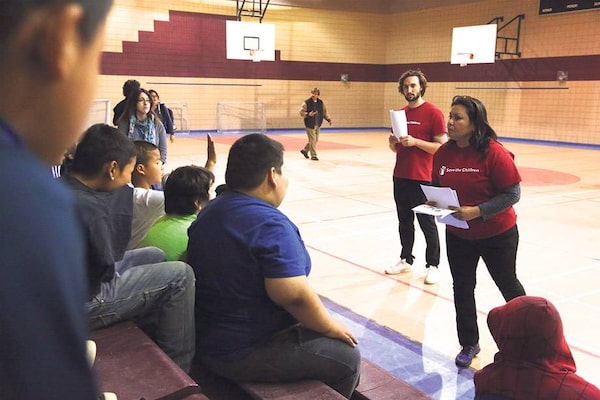
A team from Save the Children’s Building Resilience with Indigenous Children and Families program working with First Nations children in Peguis, Manitoba.
When flooding displaced about 200 people from a small Manitoba community earlier this year, community members were prepared. They had an emergency plan that included setting up Child Friendly Spaces and distributing emergency backpacks containing essential items to local children.
Just two months before the flood, the community worked with Save the Children to strengthen the capacity for dealing with emergencies like this. "After the event, we heard from the emergency manager that the training had come just in time, and people were able to put their skills and plans into action," says Lewis Archer, who is responsible for Save the Children's Building Resilience with Indigenous Children and Families program.
Being prepared can make a big difference, and children need to be part of the plan. When disasters strike, the family and social structures children depend on are often disrupted and a return to normalcy can take time, says Mr. Archer.
"Child and youth focused emergency preparedness is part of Save the Children's global portfolio and body of expertise," says Lindsey Quarrie, corporate partnerships manager at Save the Children Canada. "With a generous philanthropic grant from GlaxoSmithKline (GSK), our program is working to ensure that the unique needs of children in First Nations communities are met during emergencies."
Employees at GSK are directly involved in supporting the program by holding annual events where they equip emergency backpacks, which will be distributed to children, with essential items. "GSK colleagues have a lot of pride and passion for the work Save the Children does here in Canada and globally," says Alison Pozzobon, director of communications and community partnerships at GSK. "They are especially energized knowing that a couple hours of their teamwork makes a positive impact on First Nations children in Canada who may face emergencies in their community."
"Many of the First Nations communities we work with are rural, remote and located near large bodies of water or forests, making them particularly susceptible to extreme weather and disasters," says Mr. Archer. Recent decades have seen up to eight times as many disasters in Canada as 100 years ago. Between 2009 and 2015, 480 "natural hazards" affected First Nations communities, with the primary hazard being flooding, followed by fires and hail.
To ensure the communities can respond to emergencies in an appropriate and timely way, Save the Children engages with community stakeholders who work with children. Training can include scenarios for evacuating schools and setting up Child Friendly Spaces, which are designed to meet the immediate needs for children's protection while also creating foundations for recovery, says Mr. Archer. "When children can play in a supervised and safe space, this gives them a sense of normalcy and routine. Meanwhile, their parents are free to deal with the stresses of an emergency."
In working with nine First Nations communities, Save the Children is building on existing capacity and integrates strong networks between First Nations communities into an emergency plan. Mr. Archer mentions one example that particularly inspired him: "Some of the communities we work with didn't experience an emergency this year. So when they heard a community 200 kilometres north evacuated due to a fire, they immediately sent resources from the program, including emergency backpacks, to the communities in need."
This content was produced by Randall Anthony Communications, in partnership with The Globe and Mail's advertising department. The Globe's editorial department was not involved in its creation.